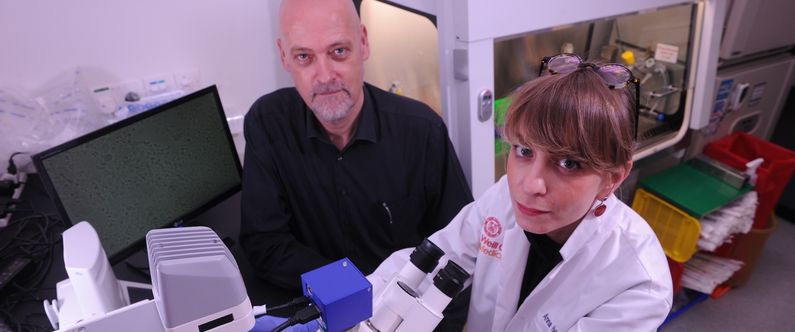WCM-Q researchers suggest malaria drug could make cancer treatments more effective
 Dr. Karsten Suhre and Dr. Anna Halama.
Dr. Karsten Suhre and Dr. Anna Halama.
Researchers at WCM-Q have discovered that an existing malaria drug could improve the effectiveness of a new class of cancer therapies, called glutaminase inhibitors, if used in combination.
The research, led by WCM-Q’s Dr. Anna Halama and Dr. Karsten Suhre, analyzed the metabolic processes of cancer cells to show that the quinine-based malaria drug Chloroquine could boost the effectiveness of glutaminase inhibiting drugs, which are currently being developed by global pharmaceutical companies.
Glutaminase inhibitors target a chemical process called glutaminolysis, in which the amino acid glutamine is broken down, releasing energy that cancer cells use to grow. Glutaminase inhibitors seek to disrupt this process, thereby depriving cancer cells of their energy source and slowing or stopping their growth. However, certain cancer cells can activate alternative ways to generate energy and thereby escape the drug’s action. This is where a new research approach called “rational metabolic engineering” comes in.
Dr. Halama, research associate in physiology & biophysics, explained: “We expose cancer cells grown in the laboratory to different doses of an anti-cancer drug and then measure the changes in almost all of the small molecules that are present in the cells, using a technique called metabolomics. Using sophisticated computational methods we then identify the molecules that the cancer cells are using to escape the drug’s actions, and conceive ways to block that escape route.”
Dr. Halama continued: “In this first application of our new approach to glutaminase inhibitors, our research focused on two specific energy pathways that cancer cells use: lipid catabolism, which is the breakdown of fats, and autophagy, in which cells derive energy by degrading parts of their own structure. We found that both of these energy pathways were accelerated when the glutaminolysis pathway was suppressed with drugs, and that this allowed the cancer cells to survive. Since the anti-malaria drug Chloroquine is known to disrupt some of these energy-producing mechanisms, our research prompted us to theorize that giving Chloroquine in combination with the glutaminase inhibiting drugs could lead to an improved suppression of tumor cells, which turned out to be the case.”
Dr. Suhre, professor of physiology & biophysics and director of the bioinformatics core at WCM-Q, is one of the world’s leading metabolomics experts. He said: “The beauty of metabolomics profiling is that it lets us see how the cell’s metabolism behaves in different situations and with a very high level of detail. So with this method we can get very useful insights into the effects a drug has on the metabolism of tumor cells, helping us to understand how the disease works and to identify targets for potential new treatments.”
The paper, entitled ‘Accelerated lipid catabolism and autophagy are cancer survival mechanisms under glutaminolysis inhibition’, has now been published in Cancer Letters, a highly regarded international medical journal.
This research could have significant clinical implications, as Chloroquine is an existing drug therapy that has been approved by the Food & Drug Administration in the US for many years, potentially offering doctors and researchers a relatively simple way to improve treatment outcomes for cancer patients who receive glutaminase inhibitors in their treatment.
Dr. Halama said: “The combined approach used in this study is uniquely relevant for future therapeutic strategies in cancer treatment and can be easily generalized to other drugs. The next important step is to test the efficacy of Chloroquine in combination with glutaminolysis inhibitors in a clinical trial.”
Dr. Khaled Machaca, associate dean for research at WCM-Q, said: “This type of research combining deep -omics phenotyping under specific pathological conditions identifies novel therapeutic interventions, in this case applied to cancer, that could be powerful in terms of disease interventions. The funding provided by QNRF for this type of research goes a long way toward both improving our basic knowledge base and generating potential therapeutic tools for Qatar and the world.”
The study was fully supported by Qatar National Research Fund (QNRF) grant NPRP8-061-3-011.
The paper can be found at https://doi.org/10.1016/j.canlet.2018.05.017